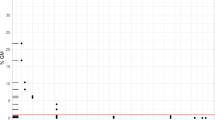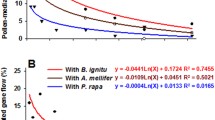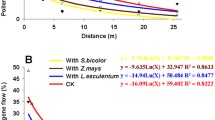Abstract
In this paper, we consider the pollen-mediated gene flow of purple-colored maize lines during co-cultivation with yellow-grain pollen-recipient maize lines. We analyze the factors influencing pollen dispersion: wind (speed and direction), distance, the synchrony of the pollen donor and receptor flowering. It was established that the maximum percentage of crosses in maize lines with the same flowering dates was recorded at the distance of 1–4 m from the donor plant. The percentage of crosses decreased by a factor of 5 with an increase in the distance to 10 m. At a distance of 40 m from the donor plant, the percentage of hybrid grains among the freely pollinated grains of the recipient plant fell by a factor of 12.5. At close distances (1–4 m), hybrid grains on the cobs of the recipient lines were observed 4 times longer in the line with earlier flowering periods or in the line with the same flowering times, but with a sharper angle of leaves. According to our experimental data, at a distance of 10 m from the maize of a pollen donor, the guaranteed does not exceed the Russian threshold of 0.9% of the presence of GMO products in food (yield). The analysis of experiments on maize spreading with pollen in Volga region of Russia provides evidence-based recommendations for safe co-cultivation of non-GM and GM varieties and maize lines at the distance 10 m.
Similar content being viewed by others
REFERENCES
United States Department of Agriculture, World Agricultural Production, Current Report, Circular Ser. WAP 7—19, 2019. https://apps.fas.usda.gov/psdonline/ circulars/production.pdf.
ISAAA, Global Status of Commercialized Biotech/GM Crops: 2016, ISAAA Brief, no. 52, New York: ISAAA, 2016.
Chumakov, M.I., Gusev, Yu.S., Bogatyreva, N.V., and Sokolov, A.Yu., Risks of pollen-mediated gene flow from genetically modified maize during co-cultivation with usual maize varieties (a review), S.-kh.Biol., 2019, vol. 54, no. 3, pp. 426—445. https://doi.org/10.15389/agrobiology.2019.3.426rus
Devos, Y., Reheul, D., and De Schrijver, A., The co-existence between transgenic and non-transgenic maize in the European Union: a focus on pollen flow and cross-fertilization, Environ. Bios. Res., 2005, vol. 4, pp. 71—87. https://doi.org/10.1051/ebr:2005013
Riesgo, L., Areal, F.J., Sanvido, O., and Rodriguez-Cerezo, E., Distances needed to limit cross-fertilization between GM and conventional maize in Europe, Nat. Biotech., 2010, vol. 28, pp. 780—782. https://doi.org/10.1038/nbt0810-780
Chamecki, M., Gleicher, S.C., Dufault, N.S., and Isard, S.A., Diurnal variation in settling velocity of pollen released from maize and consequences for atmospheric dispersion and cross-pollination, Agr. Forest Meteor., 2011, vol. 151, pp. 1055—1065. https://doi.org/10.1016/j.agrformet.2011.03.009
Marceau, A., Gustafson, D.I., Brants, I.O., et al., Updated empirical model of genetically modified maize grain production practices to achieve European Union labeling thresholds, Crop Sci., 2013, vol. 53, pp. 1712—1721. doi 10.2135cropsci. 2012.04.0224
Luna, S., Figueroa, J., Baltazar, B., et al., Maize pollen longevity and distance isolation requirements for effective pollen control, Crop Sci., 2001, vol. 41, pp. 1551—1557. https://doi.org/10.2135/cropsci2001.4151551x
Angevin, F., Klein, E., Choimet, C., et al., Modélisation des effets des systèmes de culture et du climat sur les pollinisations croisées chez le maïs: isolement des collectes et maîtrise des disséminations au champ, Rapport du groupe 3 du programme de recherche: pertinence économique et faisabilité d’une filière sans utilisation d’OGM, INRAFNSEA, Meynard, J.-M. and Le Bail, M., Eds., Thiverval-Grignon, 2001, pp. 21—36.
Ma, B.L., Subedi, K.D., and Reid, L.M., Extent of cross-fertilization in maize by pollen from neighboring transgenic hybrids, Crop Sci., 2004, vol. 44, pp. 1273—1282. https://doi.org/10.2135/cropsci2004.1273
Westgate, M., Lizaso, J., and Batchelor, W., Quantitative relationship between pollen-shed density and grain yield in maize, Crop Sci., 2003, vol. 43, pp. 934—942. https://doi.org/10.2135/cropsci2003.9340
Funding
This work was supported by grant no. 18-29-14048mk from the Russian Foundation for Basic Research and the Program for Fundamental Scientific Research of the State Academies of Sciences for 2018–2020 (state registration number AAAA-A17-117102740101-5).
Author information
Authors and Affiliations
Corresponding author
Ethics declarations
The authors declare no conflict of interest.
This article does not contain any research using animals as an object. This article does not contain any research involving people as an object.
Rights and permissions
About this article
Cite this article
Gusev, Y.S., Volokhina, I.V., Moiseeva, E.M. et al. Evaluation of Pollen-Mediated Gene Flow from Purple-Colored Maize Line during Co-Cultivation with Yellow-Grain Maize Lines. Russ J Genet 56, 1252–1254 (2020). https://doi.org/10.1134/S1022795420090082
Received:
Revised:
Accepted:
Published:
Issue Date:
DOI: https://doi.org/10.1134/S1022795420090082




